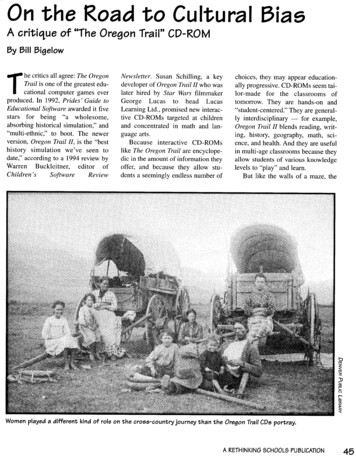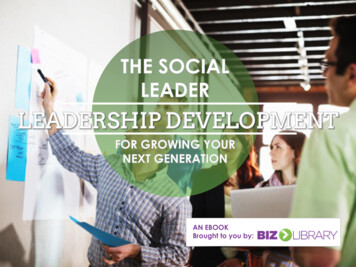
Transcription
BROUGHT TO YOU BY1
2IT’S AN AI AI AI AI WORLD
IT’S AN AI AI AI AI WORLDT H E M A N Y WAY SM A R K E T E R S H AV EBECOME AI EXPERTSWITHOUT EVENKNOWING IT YE TTABLE OF CONTENTS468122022To AI, or Not to AI:Clever technology or client-stealing menace?Either way, AI is here to stayMarketers Embrace AI:AI’s present is just as bright as its future,according to these statsAI Q&A:Serge Belongie talks AI, Alexa’s post-voice futureand Warby Parker AR glassesEveryday AI:13 examples of how you’ve actually beenusing AI all alongAI in the Wild:These brands are taking AI to the mainstream—in a very consumer-friendly wayAye Aye, AI:How AI aims to make marketers even busier3
ToAI,OrNotToAI4There’s a momentin Spike Jonze’s movie Her when Samantha,an operating system, tells Theodore that bycurating the thousands of personal letters he’swritten for his customers and selecting justthe right passages to showcase their collectivepoignancy, getting him a book deal was easy.Such is the power of perfect knowledge.Is it any wonder he wasn’t the only characterdating his laptop?Few topics ignite theimagination more thanartificial intelligence, or AI.To Elon Musk, “It ’s atechnology with the capacityto enslave us,” and hedoesn’t tire of ringing thealarm bell. And accordingto a report commissionedby Weber Shandwick,even if AI-fueled machinesnever quite ascend torulers of the universe,there are plenty of people(82% of all consumers, infact) who believe AI willdestroy their jobs.But to a great many others,nothing could be furtherfrom the truth. These folkssee AI as a technologypoised to free us from theruthless burden of toil. Ata minimum, it’s essentialto improving economicproductivity and raisingwages, a notion endorsedby President Obama inthe waning days of hisadministration.So what’s the truth? It’ssimple: AI is already fullyenmeshed in all aspects ofthe global economy, andits role will continue togrow as more and morepeople embrace the valueit offers, as this report willmake clear. Moreover, AIisn’t likely to eliminate themarketer’s job any timesoon. In fact, we see AI asa range of technologiesthat will make the marketer’sjob busier than ever. Forevery campaign, everycustomer interaction,every product decisionthat your company willmake, it will want thebenefit of perfect knowledgethat only AI can deliver.IT’S AN AI AI AI AI WORLD
“In contrast with ourintellect, computersdouble their performanceevery 18 months the danger is real thatthey could developintelligence and takeover the world.“— Stephen Hawking5
MARKETERSEWhy so much ado aboIt’s quietly become a major player in the worldeconomy, and its influence will only increase inthe coming years. Marketers, in particular, arecommitted to adopting multiple AI disciplinesfor their organizations.68%58%655%16%68% of CMOs report that their companyis currently selling, using or planningfor business in the AI era.55% of CMOs expect AI to have a greaterimpact on marketing and communicationsthan social media ever had.58% believe that within the next fiveyears, companies will need to competein the AI space to succeed.16% of organizations recently surveyed byTata Consultancy Services that use AI toimprove media buying.IT’S AN AI AI AI AI WORLD
EMBRACEAIout AI?Rather than running and hiding, marketers are laying thegroundwork to incorporate it into their organizations:78 48%%80 19%%78% of brands expect to providecustomer experiences through virtualreality in the next four years.48% of brands have implementedautomation technologies in sales,marketing and customer service,with another 40% planning to doso by 2020.80% of brands will use chatbots forcustomer interactions by 2020.19% of global companies surveyed by TataConsultancy Services that use automationtools to anticipate customer purchases andpresent offers accordingly.SOURCE:“The Past, Present and Future of AI in Marketing,” Marketing News, December 2016. “AI-Ready or Not,” a report commissioned byWeber Shandwick and conducted by KRC Research in June 2016. “The Rise of the Machine: Are Robots After Your Job?,” MarketingWeek, January 2017. “Neural Networks and Modern BI Platforms Will Evolve Data and Analytics,” Gartner Group, January 16, 2017.Survey by Tata Consultancy Services, 2017.7
COMPUTER VISIONEXPERT SERGE BELONGIETALKS AI, ALEXA’S POSTVOICE FUTURE AND WARBYPARKER AR GLASSESAt first glance, SergeBelongie might looklike just another chillguy in a t-shirt, whomight even be in a rockband, but his unpretentiousappearance belies a deepand earned expertise incomputer vision. Before hiscurrent academic gig as aprofessor of ComputerScience at Cornell Universityand Cornell Tech, where heteaches courses in machinelearning, Belongie taught atthe University of California,San Diego and co-foundedseveral startups in thecomputer vision space. Forthe last four years, Belongiehas also been helping organizethe LDV Vision Summit, anannual two-day gatheringof technologists, investors,academics, entrepreneursand anyone else interested8in the computer visionspace. We spoke withBelongie right after thelatest the LDV VisionSummit to get his take onthe computervision space past, presentand future.IT’S AN AI AI AI AI WORLDIT’S AN AI AI AI AI WORLD
WHAT WAS THE IDEA BEHIND THIS YEAR’S LDVVISION SUMMIT VERSUS PREVIOUS YEARS?Serge Belongie: The first time we did this, in 2014, the deep learning tsunamihadn’t fully hit yet. Certainly within academia it was clear that deep learning wasgoing to have a huge impact as early as 2012, because there was a seminal paperthat came out near the end of that year. But it took a few years for deep learningto attain critical mass within the industry. So the idea of having a summit that wasfocused on visual technologies in particular was a bit of a risk, because it seemedlike it might be too narrow. A lot of things that seem ubiquitous now just didn’texist before.WHAT KINDS OF THINGS?SB: This was before the boom in selfdriving cars and also before TensorFlow,which seems like it’s been around foreverand is already taken for granted, but infact it’s still quite new. What’s emergedis this incredible commoditization ofso many parts of computer vision andmachine learning that used to requireteams of Ph.Ds to develop, in terms ofinfrastructure, and now it’s possible forindividual hackers or developers on smallstartup teams to bring that kind offunctionality to any kind of product.I think there’s a general sense that there’san unstoppable force involving computervision and machine learning that’s goingto propel us towards wearables, verylightweight powerful devices that kindof disappear in to the fabric. There’s thiscommoditization and a sense that it’salmost no longer necessary to talk aboutcomputer vision and machine learning fortheir own sake.AI IS ALMOST AN OVERUSED TERM TODAY, AND CAN MEAN ANYTHING FROMBASIC VOICE RECOGNITION, OFTEN CALLED “NARROW” OR “SPECIFIC AI,”TO SCARLETT JOHANSSON’S CHARACTER IN HER, WHICH IS REFERRED TOAS “GENERAL AI.” WHAT IS AI TO YOU?SB: I still think of general AI as sciencefiction. The AI that mostly works todayand for the next five to ten years isactually just increasingly powerful formsof automation. Most people talk about AItoday in the business world in terms ofutility, like collision avoidance and lanekeeping assist that’s essentially cruisecontrol on steroids.I don’t actually use the term AI todescribe what my group at Cornell Techdoes, but, as it turns out, my universityuses the term to describe what I do.That’s true at a lot of universities becausethe general public knows what AI is, butthey don’t know what computer visionand machine learning are.9
SO WHERE ARE WE WITH AI NOW?SB: I’m going to share an analogy I heard from a dean at Cornell Tech. Theextent to which scientists have captured AI is at the reptilian level, andhe’s referring to the reptilian brain, which enables tasks that a reptile canaccomplish within 200 milliseconds, like hearing a particular sound andreacting or seeing a bug and taking an action. Reptilian cognition is notparticularly complex, but it’s still something that’s very powerful visuallyand presumably auditorily as well.We’re at the point where if you can get the training data, a computer visionsystem can beat you every single time on specific tasks like classifyingmold in an apartment, grading or scoring cancer in tissue samples, classifyingbirds, you name it. Lay down all these potential problems, collect the trainingdata, label it, run it through deep learning and that thing will just beat everyoneexcept the top experts, and sometimes even then. But again, this is all veryfocused in terms of “what is this thing in this image.” As long as you key up thatproblem, the machine is going to beat you.THAT ALL SOUNDS FAIRLY PRACTICAL AND NON-LETHAL . ARE THEDOOMSDAY WARNINGS ABOUT AI’S FUTURE OVERSTATING THE CASE?SB: Yes. Although a lot of famous and successful people out there are talking about apocalypticscenarios like Terminator and Skynet, the people in the trenches—scientists who are working incomputer vision, natural language processing and all sorts of applied AI—think, at least privately,that this kind of sci-fi talk is silly. I mean, we all take the ethics aspect of it very seriously, butto look at a computer that wins at Go and then extrapolate from that something like the AlphaGosystem, and then extrapolate that humanity’s future is on the line, is just a really big leap.HOW BIG OF AN ISSUE IS GETTING GOOD DATA?SB: That’s definitely a huge problem: How dostartups survive in the shadow of Google,Facebook and these other huge companiesthat have so much data, verticals andcomputation power? For one, there definitelyseems to be room for many niche applicationswhere certain stakeholders don’t want theircontent in the cloud, like semiconductormanufacturing or pharmaceuticals, wherethe microscopic images are of great value.Companies might not want to give competitorsthe chance to see those images that give awaya new drug that’s been discovered or a chipthat’s been created.And that certainly fits in with this push towardsedge computing, where we are moving, again,away from all these cloud services like Amazon,Google and Facebook. Even so, the vast bulkof the general public is just heaping data onGoogle, Facebook, Amazon and so on, so it’sjust incredibly difficult to compete. Now, alot of these startups are actually aiming to getacquired, because these companies areso hungry for talent.NEXT-GEN INTERFACES LIKE THE VOICE-ENABLED ALEXA, WHICH HAS JUST ADDEDA CAMERA, ARE GROWING IN POPULARITY. WILL VISION- AND VOICE-ENABLEDINTERFACES OF THE FUTURE REPLACE TODAY’S TOUCHSCREEN AND KEYBOARD?SB: I don’t think so. There’s something about touchscreens and keyboards—when lumped togetheras input devices—that’s hard to let go of. They’re still just so precise. Sometimes you just want avery specific thing—an emoji, let’s say. Obviously, with things like Google Lens and Amazon Alexa,there’s definitely a push toward making search visual or auditory. I definitely think there’s goingto be another fully-fleshed out input medium for searching, but all these are ultimately pointingback to the idea of multi-modal or multimedia search. If you know exactly what you want, youshould just type it in and not monkey around at all. Other times, you have no idea what somethingis called, but you can take a picture of it.10IT’S AN AI AI AI AI WORLD
HOW DO COMPUTER VISION AND NATURAL LANGUAGE PROCESSINGCOMPARE WITH THEIR HUMAN EQUIVALENTS?SB: Audio processing andcomputer vision are cousinfields in some ways. Theyboth attach to machinelearning in roughly the sameway, and they both work reallywell when in a controlledenvironment. Computer visionworks best when dealingwith a well-composed, welllit photo, with one mainobject taking up the field ofview. Same with Alexa’s audiorecognition, which worksbest if there isn’t too muchbackground noise.But when you start tocreate background noise,multiple people talking andsaying “um” and “ah,” or lowlight images — these arechallenges still for computersystems, but which humanvisual and auditory systemsare still amazingly goodat dealing with. The bigadvances we’re seeing on themachine end are still in therelatively controlled settings,but we will just graduallymove up from there.Advancing in this area isimportant for semi- andfully autonomous vehicles,where it’s all an uncontrolledenvironment. There’s noway to predict when thatpedestrian is going to popout in front of you, whereasthe typical domestic settingof a Google Home or an AmazonAlexa is still considerablymore controlled.HOW DO YOU FEEL ABOUT AR AND VR IN THE COMPUTER VISION SPACE?SB: I don’t track VR very much, but I do stayon top of augmented and mixed reality, andit’s exploding right now. And this despiteGoogle Glass’s hiccup and Magic Leapcreating some confusion by making somebig promises and putting out these dazzlingconcept videos in which it’s unclear what’sreal and what’s fake. But putting aside theseanomalies, the new HoloLens is amazing.And Meta has a good set of goggles, andthere’s just a really mature technology stackfor simultaneous localization and mapping.Independently of HoloLens, Microsofthas some cool new optic technology fornear-field imaging.Some cool stuff is happening with augmentedreality and mixed reality, but I think it’s stillin that brick-sized cell phone phase. And youneed to have quite an imagination to just jumpahead and say that this AR or MR wearablewill eventually be really lightweight, andthe battery will last a long time, and all that.Right now, the hardware is still very clunky,but I’m convinced it’s going to be huge.AR and MR are going to be the way that weactually experience all this computer visionand machine learning functionality. Rightnow, of necessity, we do it via this phone inour pockets that we have to pull out, but it’sall clearly moving to AR and MR.SO WHAT NEEDS TO HAPPEN FOR THAT TO BE AREALITY? GOOGLE GLASS CONTACT LENSES?SB: I don’t think we have to go all the waydown to contact lenses, but imagine apair of Warby Parker glasses, or thosespectacles from Snap—something thathas that kind of form factor would beenough. So once we get to a pointwhere it’s comparable in weight to aregular pair of glasses, but has theimage projection capability withwide field of view, a battery thatlasts all day and it’s low cost—that’swhen we’ll have arrived.11
Everyday AIIt’s often said that artificial intelligenceis the future of marketing. But whatpeople don’t always recognize is thatAI is already an integral part of thedigital ecosystem as it exists today.Indeed, if you work in advertising,marketing, sales or customerservice, there’s a good chanceyou use some form of AI everysingle workday. Whether you’rea marketer applying predictivealgorithms to optimize creativemessaging or a customer servicemanager employing chatbotsto answer people’s questions,artificial intelligence has becomea fact of life inside the 21st-centuryoffice. And even on the weekends,the apps you use to stream music,play games and connect withfriends are harnessing the powerof machine learning to give youa personalized user experience atevery turn.Don’t believe us?Here are 13 ways you may be usingartificial intelligence right now.12IT’S AN AI AI AI AI WORLD
WHAT YOU CALL IT:SEARCH ENGINESWHY IT’S CONSIDERED AI:AI empowers search engines to showpeople the right results, even if the usercan’t articulate exactly what they’relooking for.For instance, Google uses an AI systemcalled RankBrain to guess what usersmean when they’ve entered a querythe search engine is unfamiliar with.Through machine learning, RankBrainis able to translate words and phrasesthat Google has never seen before intomore familiar phrases that have asimilar meaning.WHAT YOU CALL IT:PROGRAMMATIC ADVERTISINGWHY IT’S CONSIDERED AI:If you’ve ever run a programmatic advertisingcampaign, you’ve taken advantage ofcomputational advertising—a series ofalgorithms that allow marketers to deliverthe right ad at the right moment, basedon factors like the user’s demographicinformation, their past online behaviorand the content they’re looking at whenthe ad appears.This technology also allowed the adagency Saatchi & Saatchi LA to showFacebook users customized Toyota adsthat recommended they take up weirdactivities based on their specific interests.For instance, people who were bothmartial arts enthusiasts and barbecuefans saw ads suggesting they try out ahobby called the “Tai Kwan Tenderizer.”This past October, the lingerie brandCosabella actually replaced its marketingagency with an AI platform created by thetechnology company Adgorithms. Theplatform optimizes campaign spendingautonomously based on real-time results,and it can even make creative recommendationswhen certain ad units outperform others.13
WHAT YOU CALL IT:IN-IMAGE ADVERTISINGWHY IT’S CONSIDERED AI:Contextually relevant, in-image advertisingrelies on a machine learning techniquecalled a neural network, a series oflearned mathematical functions thatprocess information in a manner similarto the human brain.By feeding millions of labeled images intoa neural network, GumGum has trainedits AI technology to identify all kindsof objects, people, colors, concepts andbrand logos. This way, the technologycan place an appropriate ad inside everyimage. For instance, a parent mightsee an ad for notebooks within a photodepicting a school.WHAT YOU CALL IT:CONSUMER PROFILINGWHY IT’S CONSIDERED AI:With consumer profiling, brands use largescale data analysis to sort their customersinto different groups based on theirdemographic information, past purchases,offline behavior and online browsing history.Through predictive analytics, marketers caneven identify when consumers are goingthrough major life events—the time periodsduring which they are most likely to switchup their shopping habits.In one famous example, Target used itscustomers’ past purchase activity to sendmailers featuring baby products to womenit predicted to be pregnant, tipping offone father before his daughter had toldhim the news.14IT’S AN AI AI AI AI WORLD
WHAT YOU CALL IT:LEAD NURTURINGWHY IT’S CONSIDERED AI:Automated sales assistants use artificialintelligence to hold introductoryconversations with a company’sprospective customers. This allowsfirms to collect contact information,promote product features and weedout unlikely customers at scale—allwithout engaging their humansales teams.For instance, Conversica’s automatedsales assistant uses natural languageprocessing to conduct email and chatconversations that feel authenticallyhuman. Once the AI has provided theperson on the other end with relevantinformation and determined that theyare a potential customer, the qualifiedlead is passed along to a humansalesperson to close the deal.WHAT YOU CALL IT:PRODUCT MARKETINGWHY IT’S CONSIDERED AI:Online retailers deliver personalized productrecommendations via collaborative filtering,an AI solution that links site visitors toother consumers who have similar tastes.If User A and User B both buy the same fiveproducts in May, there’s a good chanceUser A will be interested in the first productUser B purchases in June.Collaborative filtering is the secret saucethat powers Amazon’s insanely powerfulproduct recommendation engine and thebasis for its popular “customers whobought this item also bought ” suggestions.15
WHAT YOU CALL IT:DYNAMIC PRICINGWHY IT’S CONSIDERED AI:Dynamic pricing uses machine learningto set the optimal price point for a seller’sgoods and services at any given moment,based on what people have been willingto pay for the product under similarcircumstances in the past. It’s why airlineticket prices fluctuate depending on whenyou buy them, and why you’re likely toget hit with a surge pricing fee if you usea ride-sharing app on a Saturday night.In the e-commerce world, a companycalled Feedvisor automatically optimizesprices for sellers on the Amazon Marketplace,allowing them to maximize their revenueswhile remaining competitive with rival sellers.In the marketing realm, Google’s dynamicprice f loors automatically adjust theminimum amount of money a publisherwill accept for a given ad impression,based on what buyers have previously paidfor similar inventory.WHAT YOU CALL IT:1:1 MESSAGINGWHY IT’S CONSIDERED AI:Digital publishers provide each user with anengaging, personalized experience througha form of AI known as passive user interface.This method continuously collects behavioraldata from consumer devices, using machinelearning to tailor the experience to theconsumer’s wants and needs.If you’ve ever used Spotify’s Running feature,you’ve benefited from passive user interface.The app collects fitness tracking data fromusers’ phones in order to match the beat ofthe music to the runner’s pace.16IT’S AN AI AI AI AI WORLD
WHAT YOU CALL IT:SOCIAL MEDIA MONITORINGWHY IT’S CONSIDERED AI:If it weren’t for artificial intelligence,marketers would have a hard timemaking sense of social media. Forinstance, data analysis algorithmsidentify which customers are drivingthe discussion online, while naturallanguage processing uncovers thesentiment behind the countlessmessages people post about brandseach day.With a social media monitoring platformlike Tracx, brands can see when aninfluential user has posted a negativecomment about them, allowing thecustomer service team to fix theinf luencer’s problem before moredamage is done.WHAT YOU CALL IT:MESSAGE DEVELOPMENTWHY IT’S CONSIDERED AI:By collecting data on how people interact(or don’t interact) with the ads they see,advertisers and publishers are able to buildfeedback loops that empower them to showthe user a more relevant message in thefuture. For instance, if you click on an adpromoting a floral-print dress, the advertiserwill know to show you ads featuring similarpatterns moving forward.By the same token, Facebook learns a littlebit more about your preferences everytime you click on, ignore or hide an ad onits platform.17
WHAT YOU CALL IT:SALES SUPPORTWHY IT’S CONSIDERED AI:In recent years, chatbots have becomean increasingly popular tool for carryingout sales support functions at all kindsof companies. These virtual assistantsuse natural lang uage processing tounderstand customer questions andprovide useful information in response.As an example, Amtrak employs a virtualassistant named Julie to help customersbook their travel without tying up a humancustomer representative. According tothe company that developed the chatbot,Next IT, Julie answers about 5 millionquestions each year.WHAT YOU CALL IT:AUTOMATIC CONTENT CREATIONWHY IT’S CONSIDERED AI:At the forefront of artificial intelligence,brands and publishers are using naturallanguage generation to automatically turndata points into written content—withoutthe use of human writers.For instance, Narrative Science’s AutomatedDescription product can quickly generatein-depth summaries of real estate properties,complete with short reviews of nearbyrestaurants. Over time, the softwareoptimizes its copy based on the descriptionsthat drive the most engagement.18IT’S AN AI AI AI AI WORLD
WHAT YOU CALL IT:SPORTS SPONSORSHIPSWHY IT’S CONSIDERED AI:The same neural networks that areutilized by in-image advertising can alsohelp brands gain greater insight intohow much their in-stadium sportssponsorships are really worth. Byidentifying when a company’s logoappears on-screen during a livesports broadcast, this technologytells brands exactly how much screentime they’re getting.GumGum’s Sports product measuresthe ROI of sports sponsorships usinga formula that takes into account howmuch time the logo spends on-screenand how prominent it is to the viewer.By comparing this metric to thenumber of people watching, we cantell you how much it would have costto buy an equivalent amount of reachand engagement across broadcastTV, streaming video and socialmedia platforms.19
AI in the WilLots of tech companies offer AI-poand even more CMOs report theynames using AI today? Here are j1202Under Armour IBMWatson Better HealthLowe’s Robo atYour ServiceUnder Armour bills its UA Record app as the“body’s dashboard.” Powered by IBM Watson,it tracks “steps, nutrition, advanced sleep dataand real-time workout stats, such as heart rate,pace, distance and calorie burn,” accordingto the app’s description. It also taps into datagathered by other fitness-tracking apps. Byfeeding that data through IBM Watson, theapp provides recommendations for nutritionand training advice, completely customized toeach user. For instance, by entering sleep data(i.e. the number of hours you slept the nightbefore), Record will tell you how your bodymass index (BMI) compares to other membersof your cohort who get more sleep.Responding to complaints aboutpoor customer service, hardwarechain Lowe’s introducedOSHbot in late 2014. The machine,which can talk and move, wasprogrammed to to greet customersand guide them to their item ofchoice, via voice recognition oran onboard touchscreen display.OSHbot was the product of acollaboration between Kyle Nel,who headed Lowe’s InnovationLabs division, and Marco Mascorro,the CEO of a robotics startupcalled Fellow Robots.IT’S AN AI AI AI AI WORLD
ldowered technology and solutions,plan to use it. How are householdjust a few ways:31-800-Flowers.com andConversational MarketingThe robot has since beenupgraded to Fellow’s JetsonTX2 platform and renamedLoweBot NVAii. LoweBot navigatesthe aisles autonomously, oftenusing cameras and odometryalone to find its destination.And once the store is closed,the LoweBot makes use of itshigh-resolution camera, LEDlight source and deep learningbased classifier to track whichitems need restocking, savingemployees a lot of time.1-800-Flowers.com isn’t shy about adopting emergingtechnologies. It’s also one of the few household namesactively working to perfect conversational commerce,an AI discipline that engages with customers using voicecommands, text and chat apps. 1-800-Flowers.com’sversion is an AI-powered digital gift concierge theycall GWYN (Gifts When You Need). GWYN helpscustomers find the perfect gift for mom or the boss,often suggesting items across its entire portfolioof products. In the process, GYN solves a challenge1-800Flowers.com has struggled with: educating themarket that they offer more than just flowers. Nowwhen consumers ask for recommendations, GWYNcan offer a variety of options, such as fresh fruit forgift recipients on health kicks.21
Aye Aye, AIAI is certainly a hot topic rightnow, as evidenced by the steadydrumbeat of stories and reportson how AI is reshaping our economyand our approach to work.What can we conclude about itspotential impact on marketersand marketing organizations?To start, AI will greatly help marketers identify trends in big data.AI is eminently suitable to crunching through massive datasets,looking for that perfect knowledge. This will be a huge stepforward for marketerkind. And through the power of naturallanguage generation, AI will be able to sift through the data, andgenerate insights in plain English for the marketer.Another key use case: creating content on the fly. Neural networkscan already reason and act with human creativity. These programsalready allow news organizations to create stories based on facts.It’s easy to imagine a world where chatbots speak with everycustomer across all of a brand’s touchpoints, picking up differencesin demographics and regional preferences to engage intwo-way conversations.22IT’S AN AI AI AI AI WORLD
Chatbots will also be used to deliver just-in-time customer serviceand sales support. Tapping into the insight generated from the collectiveinteractions across an entire customer base, chatbots will bring alevel of experience not humanly possible. Unlike humans, a chatbotnever forgets, and that huge body of knowledge will always beavailable at any moment to help a customer.At the dawn of the AI era, the special will become mundane. Tasksthat typically require marketers to call in an army of data consultants—such as determining the impact of a TV campaign on actual viewers—will be heavily automated. Whereas current technology selects a fewshows for analysis, in the AI era all shows will be routinely analyzed.Next, the impossible will becomepossible. Let’s say you’re an onlineretailer and you want to rewriteyour entire product catalog in yourbrand voice. Natural languagegeneration technologies will allowyou to do so in a relatively shorttimeframe. In addition to improvingyour Google search rankings, yourcopywriters will thank you.Neural networkscan alreadyreason and actwith humancreativity.Finally, and most importantly, the demands on the marketer will increase,even though AI is supposed to make things easier. As we get closerto perfect knowledge, marketers will want to use it in everything wedo. That means retailers will want a unique pricing strategy for everyproduct in their catalogs; CMOs will want offline sales analysis forevery online ad campaign, regardless of size; and product marketerswill look to every customer care issue raised when planning theproduct roadmap.We offer one additional proof point here: If you’re in the digital advertisingecosystem, you’ve already witnessed a ton of AI-powered automation.Are you really less busy than you were 10 years ago?We didn’t think so.23
24IT’S AN AI AI AI AI WORLD
Weber Shandwick and conducted by KRC Research in June 2016. "The Rise of the Machine: Are Robots After Your Job?," Marketing Week, January 2017. "Neural Networks and Modern BI Platforms Will Evolve Data and Analytics," Gartner Group, January 16, 2017. Survey by Tata Consultancy Services, 2017. 78% of brands expect to provide










